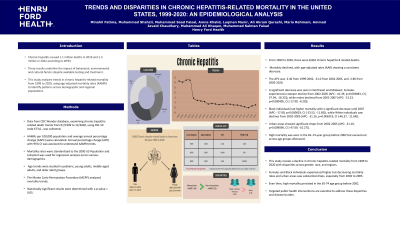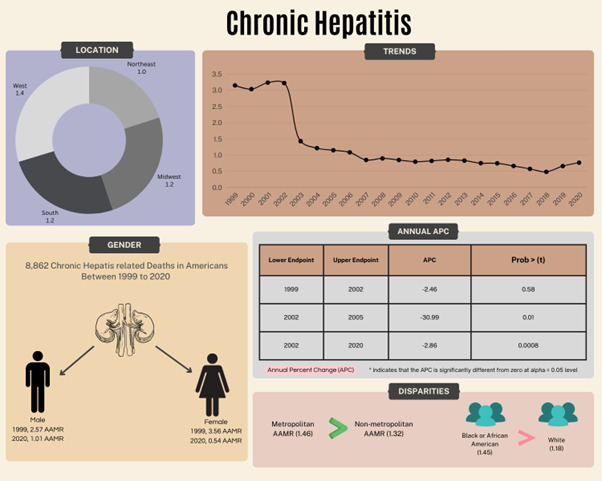Sunday Poster Session
Category: Liver
P1141 - Trends and Disparities in Chronic Hepatitis-Related Mortality in the United States, 1999-2020: An Epidemiological Analysis
Sunday, October 27, 2024
3:30 PM - 7:00 PM ET
Location: Exhibit Hall E

Has Audio

Minahil Fatima
King Edward Medical University
Detroit, MI
Presenting Author(s)
Minahil Fatima, 1, Muhammad Shahzil, MD2, Muhammad Saad Faisal, MD3, Amna Khalid, MBBS1, Luqman Munir, 1, Ali Akram Qureshi, 1, Maria Rehmani, MBBS4, Ammad Javaid. Chaudhary, MD3, Muhammad Ali Khaqan, MD5, Muhammad Salman Faisal, MD3
1King Edward Medical University, Lahore, Punjab, Pakistan; 2Penn State Health Milton S. Hershey Medical Center, Hershey, PA; 3Henry Ford Health, Detroit, MI; 4King Edward Medical University, Detroit, MI; 5John H. Stroger, Jr. Hospital of Cook County, Chicago, IL
Introduction: Chronic hepatitis caused 1.1 million deaths in 2019 and 1.3 million in 2022 according to WHO. These results underline the impact of behavioral, environmental and cultural factors despite available testing and treatment. This study analyzes trends in chronic hepatitis-related mortality from 1999 to 2020, using age-adjusted mortality rates (AAMR) to identify patterns across demographic and regional populations.
Methods: Data from CDC Wonder database, examining chronic hepatitis-related death trends from 01/1999 to 12/2020, using ICD-10 code K73.0., was collected. AAMRs per 100,000 population and average annual percentage change (AAPC) were calculated. Annual percentage change (APC) with 95% CI was assessed to understand AAMR trends. Mortality rates were standardized to the 2000 US Population and Joinpoint was used for regression analysis across various demographics. Age trends were studied in pediatric, young adults, middle adults, and older adults groups. The Monte Carlo Permutation Procedure (MCPP) analyzed mortality trends. Statistically significant results were determined with a p-value < 0.05.
Results: From 1999 to 2020, there were 8,862 chronic hepatitis B related deaths. Mortality declined, with age-adjusted rates (AAR) showing a consistent decrease. The APC was -2.46 from 1999-2002, -31.0 from 2002-2005, and -2.86 from 2005-2020. A significant decrease was seen in Northeast and Midwest. Females experienced a steeper decline from 2002-2005 (APC: -41.39, p=0.003883, CI [-57.94, -18.32]), while males declined from 2001-2007 (APC: -13.23, p=0.000405, CI [-17.99, -8.20]). Black individuals had higher mortality with a significant decrease until 2007 (APC: -17.90, p=0.000019, CI [-23.53, -11.85]), while White individuals saw declines from 2002-2005 (APC: -31.16, p=0.006319, CI [-46.37, -11.64]). Urban areas showed significant drops from 2002-2005 (APC: -31.10, p=0.009090, CI [-47.09, -10.27]). High mortality was seen in the 65-74 year group before 2002 but evened out across age groups afterward.
Discussion: This study reveals a decline in chronic hepatitis-related mortality from 1999 to 2020 with disparities across gender, race, and regions. Females and Black individuals experienced higher but decreasing mortality rates and urban areas saw substantial drops, especially from 2002 to 2005. Even then, high mortality persisted in the 65-74 age group before 2002. Targeted public health interventions are essential to address these disparities and disease burden.

Disclosures:
Minahil Fatima, 1, Muhammad Shahzil, MD2, Muhammad Saad Faisal, MD3, Amna Khalid, MBBS1, Luqman Munir, 1, Ali Akram Qureshi, 1, Maria Rehmani, MBBS4, Ammad Javaid. Chaudhary, MD3, Muhammad Ali Khaqan, MD5, Muhammad Salman Faisal, MD3. P1141 - Trends and Disparities in Chronic Hepatitis-Related Mortality in the United States, 1999-2020: An Epidemiological Analysis, ACG 2024 Annual Scientific Meeting Abstracts. Philadelphia, PA: American College of Gastroenterology.
1King Edward Medical University, Lahore, Punjab, Pakistan; 2Penn State Health Milton S. Hershey Medical Center, Hershey, PA; 3Henry Ford Health, Detroit, MI; 4King Edward Medical University, Detroit, MI; 5John H. Stroger, Jr. Hospital of Cook County, Chicago, IL
Introduction: Chronic hepatitis caused 1.1 million deaths in 2019 and 1.3 million in 2022 according to WHO. These results underline the impact of behavioral, environmental and cultural factors despite available testing and treatment. This study analyzes trends in chronic hepatitis-related mortality from 1999 to 2020, using age-adjusted mortality rates (AAMR) to identify patterns across demographic and regional populations.
Methods: Data from CDC Wonder database, examining chronic hepatitis-related death trends from 01/1999 to 12/2020, using ICD-10 code K73.0., was collected. AAMRs per 100,000 population and average annual percentage change (AAPC) were calculated. Annual percentage change (APC) with 95% CI was assessed to understand AAMR trends. Mortality rates were standardized to the 2000 US Population and Joinpoint was used for regression analysis across various demographics. Age trends were studied in pediatric, young adults, middle adults, and older adults groups. The Monte Carlo Permutation Procedure (MCPP) analyzed mortality trends. Statistically significant results were determined with a p-value < 0.05.
Results: From 1999 to 2020, there were 8,862 chronic hepatitis B related deaths. Mortality declined, with age-adjusted rates (AAR) showing a consistent decrease. The APC was -2.46 from 1999-2002, -31.0 from 2002-2005, and -2.86 from 2005-2020. A significant decrease was seen in Northeast and Midwest. Females experienced a steeper decline from 2002-2005 (APC: -41.39, p=0.003883, CI [-57.94, -18.32]), while males declined from 2001-2007 (APC: -13.23, p=0.000405, CI [-17.99, -8.20]). Black individuals had higher mortality with a significant decrease until 2007 (APC: -17.90, p=0.000019, CI [-23.53, -11.85]), while White individuals saw declines from 2002-2005 (APC: -31.16, p=0.006319, CI [-46.37, -11.64]). Urban areas showed significant drops from 2002-2005 (APC: -31.10, p=0.009090, CI [-47.09, -10.27]). High mortality was seen in the 65-74 year group before 2002 but evened out across age groups afterward.
Discussion: This study reveals a decline in chronic hepatitis-related mortality from 1999 to 2020 with disparities across gender, race, and regions. Females and Black individuals experienced higher but decreasing mortality rates and urban areas saw substantial drops, especially from 2002 to 2005. Even then, high mortality persisted in the 65-74 age group before 2002. Targeted public health interventions are essential to address these disparities and disease burden.

Figure: Trends and Disparities in Chronic Hepatitis-Related Mortality
Disclosures:
Minahil Fatima indicated no relevant financial relationships.
Muhammad Shahzil indicated no relevant financial relationships.
Muhammad Saad Faisal indicated no relevant financial relationships.
Amna Khalid indicated no relevant financial relationships.
Luqman Munir indicated no relevant financial relationships.
Ali Akram Qureshi indicated no relevant financial relationships.
Maria Rehmani indicated no relevant financial relationships.
Ammad Chaudhary indicated no relevant financial relationships.
Muhammad Ali Khaqan indicated no relevant financial relationships.
Muhammad Salman Faisal indicated no relevant financial relationships.
Minahil Fatima, 1, Muhammad Shahzil, MD2, Muhammad Saad Faisal, MD3, Amna Khalid, MBBS1, Luqman Munir, 1, Ali Akram Qureshi, 1, Maria Rehmani, MBBS4, Ammad Javaid. Chaudhary, MD3, Muhammad Ali Khaqan, MD5, Muhammad Salman Faisal, MD3. P1141 - Trends and Disparities in Chronic Hepatitis-Related Mortality in the United States, 1999-2020: An Epidemiological Analysis, ACG 2024 Annual Scientific Meeting Abstracts. Philadelphia, PA: American College of Gastroenterology.
